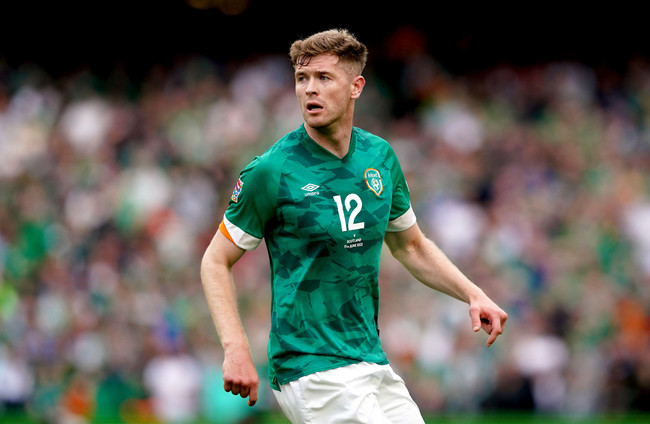LAST UPDATE | 13 Jul 2022
ROBBIE KEANE’S LONG reign has ended: he is no longer the most expensive one-off Irish transfer of all time.
Keane’s £18 million move to Liverpool from Spurs in 2008 was the priciest move up to yesterday, when Wolves paid Burnley £20.5 million to sign Nathan Collins on a five-year deal, with an option to extend the contract by a further year.
It’s an interesting move, partly in the short-term but largely in what it promises in the longer-term. The length of the contract agreed is partly down to the fact Collins is just 21, but it’s also a tacit admission from Wolves that they may be selling him on again in the future.
Football is the Collins family business and precocity is their shared trait: Nathan’s father David had his promising career at Liverpool stymied by injury, while his uncle Eamon became the youngest player ever to appear in an English league game when he played for Blackpool at the age of 14.
Starting a career equipped with that kind of experience in the game is a kind of gold-dust, and his move from Cherry Orchard to Stoke City happened under an agreement with his parents that he would go back to UCD if it didn’t work out. But it did work out and Collins became the club’s youngest-ever captain at 18, and then took a move to Burnley a year ago, leaving more glamorous clubs waiting at the altar. Burnley’s season was a misery but Collins broke through, and he has now plumped for Wolves, in spite of reported interest from Leicester. (It’s hard to think of many centre-backs who have thrived under Brendan Rodgers.)
Wolves’ Technical Director Scott Sellars yesterday explained why they made Collins their first major summer signing.
“We’re getting someone who is physically very good, very tall, very athletic, and is very comfortable on the ball – he can step in and take the ball forward, which is what we need. He’s very good in both boxes and has real aerial strength.
“The feedback on his personality is about his leadership qualities, he’s a good character, so he ticks all the boxes. He comes across as expected, a humble young man who is appreciative of the opportunity, so we’re all going to be very happy.”
Shape shift
Wolves makes sense for Collins, too. They are a team into which he can be confident of stepping into straight away, and they are more likely to be battling for a place in Europe than sweating about relegation. Wolves had largely played a back three under Bruno Lage, a system in which Collins has proven he is comfortable at international level, where he has played on the right before excelling in the centre against Ukraine.
At Wolves, he is an effective replacement for Morocco international Romain Saiss, who has left for Besiktas. Saiss, however, usually played on the left of the back three, a position where the right-footed Collins has little experience. That’s not to dismiss Collins’ versatility: he started his youth career in central midfield, and often played right-back for Stoke. (He has occasionally popped up at right wing-back, too.)
One option for Lage next season will be to swap the left-footed Max Kilman to the left of the back three, and play Collins to the right, in spite of the fact Kilman usually played on the right last season. Conor Coady won’t be shifted from the middle of the back three anytime soon.
That’s if there is a central position in which Coady can play. There are murmurings that Lage wants to change to a back four next season, a formation he played only fleetingly last season, and that was usually to try and prise a tune from dainty forward Fabio Silva, whom he decided needed a strike partner. (Silva hasn’t joined Wolves’ pre-season tour and looks set for an exit, at least on loan.)
Prior to joining Wolves, however, Lage played a back four for all of his time in charge at Benfica, to whom he led to one Portuguese title. (A success led by some kid called Joao Felix.)
Coady has proved too influential a leader to be left out of the team, but he doesn’t have the pace to play in a back four. Collins plainly does have that pace, however, and it’s interesting in that context to note Wolves cite his leadership quality as one of the reasons they signed him. Perhaps it’s a more medium-term plan, but Collins and Kilman might be the centre-back pairing that allow Lage return to his favoured 4-4-2.
Pass maths
Regardless of where he plays, Collins will have to prove he is as comfortable on the ball in the Premier League as he looked for Ireland in the Nations League last month. This is where the move is most intriguing: it’s a chance for Collins to prove to the biggest clubs that he can pass the only Premier League exams he hasn’t yet sat.
Last season, per FBRef, Collins was among the bottom 4% in the league for his total number of attempted passes, while he was in the bottom 3% for completed passes.
This, however, is most likely a result of how Burnley played under Sean Dyche: he didn’t ask his defenders to step out and help the team play through the thirds but rather to Get It Launched.
Wolves – with a midfield of Joao Moutinho and Ruben Neves – won’t be asking Collins to do the same thing. The proof is in the numbers. According to WyScout data, only Trent Alexander-Arnold and Oleksandr Zinchenko averaged more ‘progressive passes’ per game last season than the man Collins is replacing, Romain Saiss.
A progressive pass is, essentially, a penetrative one: it’s one in which the ball either travels 30 metres forward in one’s own half, 15 metres if the starting and finishing points are in either half, and 10 metres if it’s made in the opponent’s half. Among centre-backs, Saiss made more of these passes than anyone else last season, whereas Collins ranked 27th of all centre-backs, averaging just more than half as many per game. (Saiss averaged 12.19 per game, Collins 7.82.)
Again, this is probably just Dychenomics: Saiss attempted 57 passes per game last season, whereas Collins attempted an average of 34. The stats show that Saiss averaged twice as many short and medium-range passes as Collins did last season, but they were close to parity in terms of long balls. (Collins averaged five per game, Saiss made seven.)
Saiss also had the benefit of simply being on the ball more often, averaging 70 touches a game as opposes to Collins’s 47.
This is why, on the surface, this move fits so snugly.
Collins is likely to play every week at a very high level while being asked to prove he can do the one thing that hasn’t been asked of him thus far. His time at Wolves can tick the only vacant boxes left, the ones the Champions League clubs keep a particularly keen eye on.














Excellent prospect and great news for ireland he is going to wolves,than sit on the bench wit a “top 6″ club. Only 21 and still alot to learn. But he has it all as a cb tall, fast,physical, reads the game so well and a very good passer of the ball. Best of luck to him on hes new journey, wolves have got a great bargain imo.
Yep game time is important for him. Wish him well at Wolves.
It’s a great step for Nathan. He’ll be playing alongside Coady who is one of the most undervalued CHs in England. He is good enough to be playing for a top 4 club and he is a great captain and leader himself. It’s a great move for both club and player and when Nathan has a couple of years under him there he’ll move to bigger and better things earning a fortune for the club.